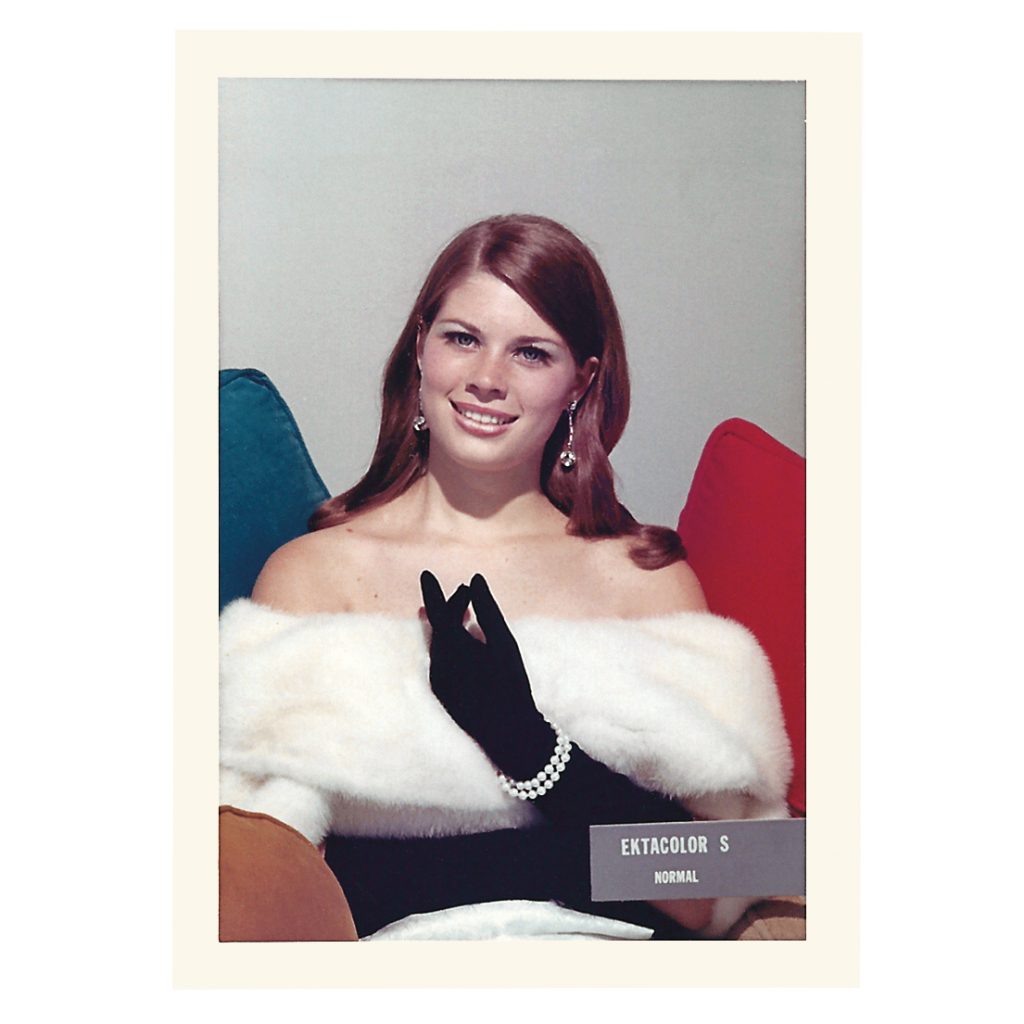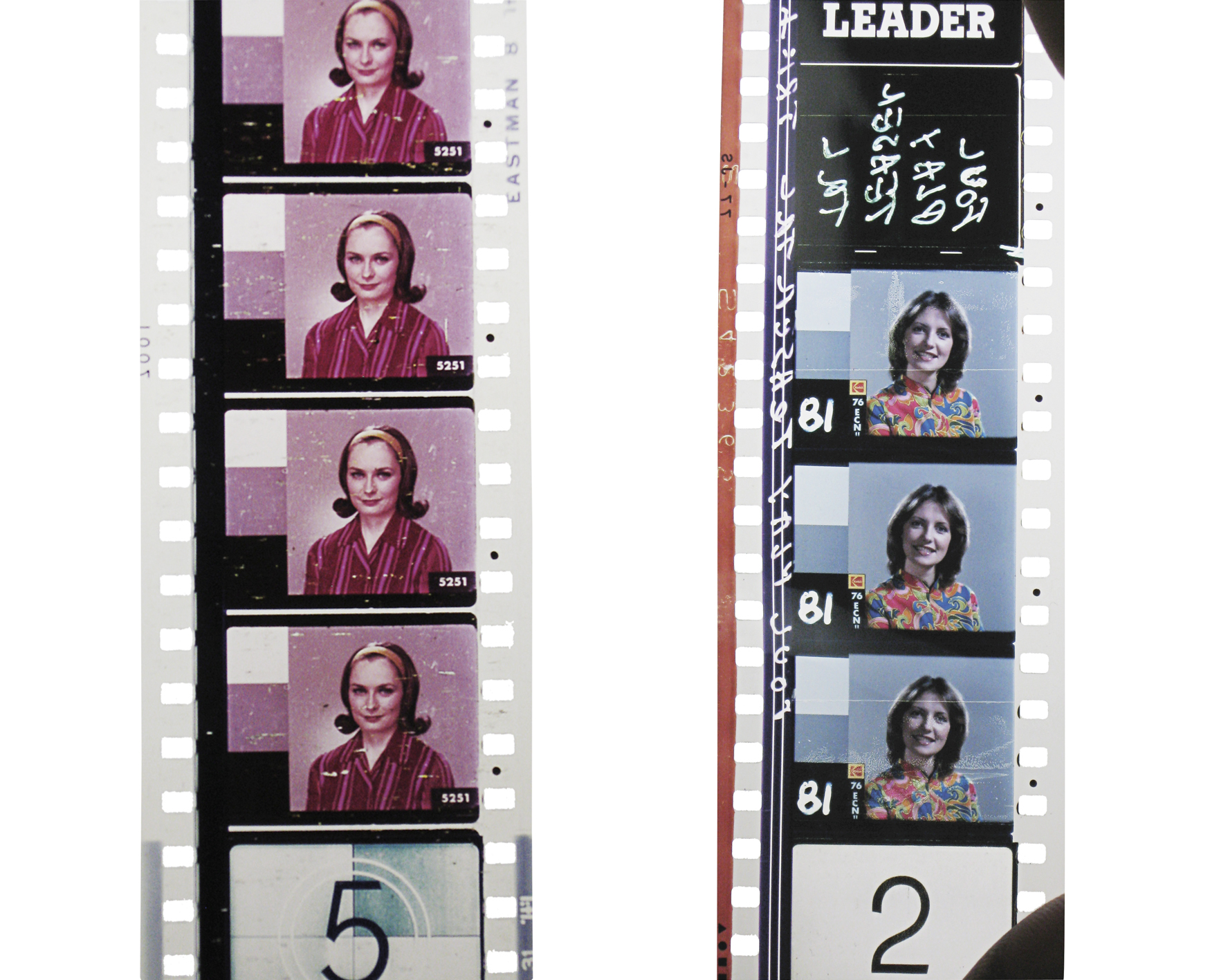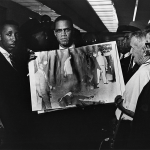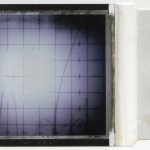A Matter of Skin
Publicado em: 23 de June de 2016Shirley cards and the racial standards that rule the visual industry.
THE MULTIPLE visual identities of Shirley, the “color balance girl,” first came to my attention in 1995 after a conversation with a buyer and seller of industrial machines in North America. He complained about a Kodak photo-processing lab that he had purchased at the time, which had caused him a great deal of frustration. No matter what calibration he technically configured to print the photos he was charged to reproduce, the final image of darker skin appeared to be muddy-looking, ashen, or so close to “black” that only the whites of the subjects’ eyes and their white teeth appeared with any detail. In photos where there were several skin tones side by side, such as high school graduation classes with various students, the challenge became even more striking as often the photographers had tried to strengthen the lighting intensity and overexpose the darker subjects to capture the highest possible skin definition. This resulted in overexposing the lighter skinned subjects as well, making the final product so visually unpleasant as to be considered an embarrassment to the photographer.
My friend’s frustration was exacerbated by the fact that none of the documentation that accompanied the lab infrastructure directions (including Kodak’s Dataguide) mentioned the possibility that diversity of skin tones might need to be considered as a critical factor in the creation of realistic renditions of human subjects. For him, as for others in the Kodak lab business, the learning process of calibrating the skin tones would be based on trial and error. Was the solution to be found in a better understanding of the materiality of film emulsion or in the improvement of problematic colour balance standards in printing?
One of the items that my friend and other lab owners received with their Kodak documentation package, designed for still photograph printing, was an image that had mysteriously become known as a Shirley card among industry technicians. Shirley’s image was that of a single light-skinned woman wearing high-contrast clothing positioned against various colour graphs and a gray scale. The cards often were tagged with the word NORMAL. The purpose of a Shirley card is to aid in the determination of exposure, image density, comparison-measuring and calibrating the skin tones on photographs being printed. It is normal to have skin colour parameters against which to compare settings, but should the term “normal” be applied to the multiple Shirleys who represent a restricted set of the many existing human fleshtones?
The original name of Kodak’s Shirley, applied to all of the cards of this type for many years, seems to have come from the first model who was pictured on the card in the 1940s. She was probably someone who worked in the office at one of the several Kodak Lab Research Centres in North America or was the wife of someone working there who was asked to sit as a model. To simplify matters of classification, those in charge of the development of the norm reference test card (as her photo was called), decided to give all the women who were pictured therein the same name: Shirley. Beside the name Shirley, what all these women had in common were their light-skins, their anonymity, and their Western look. They were attractive and often rather sexy.
Shirley and her colleagues
Shirleys were not an isolated phenomenon. Television’s Colour Girls and film’s China Girls (also known as Dolls or Girl Heads) represented the light-skinned colour balance industry standards for analog and digital TV and motion pictures for decades. TV Colour Girls were different from their sisters in the domains of photography and film. They were alive and present on the sets in analog broadcast studios around the world and reflected the dimensions of skin colour texture and variation in a three-dimensional way beginning in the era of early colour TV.
According to Jan Kasoff, former NBC colour- television camera-man on the program Saturday Night Live, there were several stages to colour balancing an analog TV camera, beyond using greyscale and colour cards. Interestingly, for the final step, “a good video engineer would have a Colour Girl stand in front of the cameras and stay there while the cameramen lined up and focused on her flesh tones to do their fine adjustments of matching and balancing the cameras colorwise. This Colour Girl was always white.”
By 2003, when the broadcast standard in the US became digital, Colour Girls were no longer needed. Soon after, they were retired from studio sets around North America. Digital camera colour balancing now uses more sophisticated electronics, light boxes, and black/white chip cards showing the dynamic range of the darkest of darks and the lightest of lights with all the incremental shifts in the colour spectrum.
Though less visible than a material Shirley card, China Girls were just as important in the colour balance process in cinematography. The name China Girls seems to have more to do with the colour of bone china, or porcelain, than with ethnicity. These women, who live as captured images on the leader of every commercial and documentary film from the late 1920s till the early 1990s, are closer in texture and dimensions to the Shirley girls who are situated on various forms of printing paper and film negatives.
Shirleys were the least known by the general public, as they really did stay behind the lab walls, their images only displayed and handled by the lab workers as a tool of clarification and reference. TV Colour Girls had always been obvious participants in the studio camera set-up process; studio audiences would have been particularly familiar with them. The China Girls continue to be in limited use today, but as an audience member in a typical film theatre, it is rarely possible to catch a glimpse of her as she occasionally moves in a split second across the cinematic screen.
The Shirley standard
In the shadows of the photographic labs, between 1940s and the present, versions of these female iconic images (in both analog and digital platforms) have appeared around the world. Fixed in time and pose, their light skin standard continues to subliminally wield normative powers among lab technicians and general viewing publics. They have crossed decades, and continents, and continue to narrowly define and guide perceptions of skin tones in photographic imagery, representing a subtle, embedded social and psychological message about the dominant value of “white” skin colour and the position of females in the industry. They further represent a particular Euro/Western beauty and gender aesthetic that conformed to the popular masculinist notion of the ideal feminine look at the time of their creation.
As a predesigned measuring tool for all human subjects in the industry, no matter what their skin colour was in real life, the popularity of the light skin standard raised several issues for photographers. If Shirleys were to be the norm against which all skin colours would be calibrated, how should technicians deal with images of people whose skins were more in the yellows, reddish and olive colours, browns, and black tones?
The implicit message that Shirley was the norm, and “the normal” was white skin, reached the height of its popularity before the civil rights movement in the United States began gaining strength. In the 1960s, Kodak lab operators and photographers in the Afro- American communities began to intuitively perceive the chemistry of whiteness embedded in their products, and so could consumers or viewers with a critical, aesthetic eye. But like so many, who naively believed that film was designed to render a photo of the real as a perfect resemblance of what is pictured, most didn’t consider that the chemistry of film emulsions could be developed on the basis of cultural choices. The belief that technologies are neutral prevailed so strongly that few would question the visual industries unless there was convincing evidence to justify their skepticism.
In 2014, after I published an article with the results of my research on the Shirley cards, an African-American photographer called Syreeta McFadden declared to the website Buzzfeed that she had always been concerned about the poor quality of her own family photos, even when a professional photographer had been hired to do photos for special occasions. In a text titled “Teaching the Camera To See My Skin: Navigating photography’s inherited bias against dark skin,” she reflected upon her negative childhood and adult experiences about the limits imposed on her image by colour film emulsion designed with lighter skins in mind. McFadden had intuitively picked up on the central issue that Kodak film emulsions embodied a bias toward lighter skins, but had been afraid to articulate this openly at the time because she didn’t have enough evidence beyond her own experience. “By the 1990s, when I began taking pictures, I hated shooting brown skin on color film. The printed results failed to accurately represent my subjects, their shades obscured, their smiles blown out. I understood that some of this had to do with harmonizing the basic components of great image-making from the gear: film speed, aperture, and the ghost we all chase, light. The inconsistencies were so glaring that for a while, I thought it was impossible to get a decent picture of me that captured my likeness. I began to retreat from situations involving group photos. And sure, many of us are fickle about what makes a good portrait. But it seemed the technology was stacked against me. I only knew, though I didn’t understand why, that the lighter you were, the more likely it was that the camera – the film – got your likeness right.”
One of the solutions to overcome this problem was to learn to adapt the technology: “We circumvented the inherent flaws of film emulsion by ensuring that our subjects were well placed in light; invested more in costly lenses that permitted a wider variety of aperture ranges so we could imbue our work with all the light we could; we purchased professional- grade films at faster speeds, or specialty films with emulsions designed for shooting conditions strictly indoor under fluorescent or tungsten light. We accepted poor advice from white photo instructors to add Vaseline to teeth and skin or apply photosensitive makeup that barely matched our skin’s undertones.”
Careful attention to a panoply of special adjustments created improved results for professionals, but what about the more economic, stock films for non-expert consumers using baseline products? How could these films and photographic results be improved? What critical factors would motivate manufacturers to increase the dynamic range embedded in their film emulsions?
Face-ing Kodak
Dynamic range in photography refers to the difference between the lightest light and darkest dark seen in a photo as well as the incremental changes of the colour continuum between these two extremes. It was the representation of this full range of colour that preoccupied international film companies’ product development technical staff.
Kodak stock film emulsions were initially designed to favour lighter skin tones. In lay terms, this means that the chemical formulae used to engineer stock film emulsions would privilege the higher reflectivity of lighter skin tones.
Yet, even as I interviewed technical and artistic staff at Kodak and several popular television networks in the US, Japan, China, Australia, The Netherlands, and Canada, I repeatedly heard the science arguments about how film and TV camera design, manufacturing processes, and practices are based on reasoned and logical decision-making without consideration of cultural or racial subtleties. After a lengthy period of resistance, however, key players in the industry in the late nineties began to quietly affirm that refinements to the chemistry of film emulsions and camera design have indeed been based on cultural discussions and choices negotiated in back rooms and labs. The critical moment of Kodak’s more open recognition of this acknowledgement is particularly surprising and interesting.

To reproduce light and dark skin tones in the same image demanded skill from the photographer, but there were technical limitations of lm and copy, which the industry took a long time to deal with. Students from Villa Maria Academy, in Bronx, New York, 1983. John R. Foldi Collection
School graduation photos that Kodak had been contracted to do in Rochester, New York, in the 1950s raised the problem that dark and lightskinned subjects in the same photo frame looked awful. The darker children had no visible facial contours or particularities in resulting images; the lighter skinned children were overexposed. However, when each child’s photo was taken individually, the results were much better due to the photographer’s knowledge of compensatory mechanisms. The complaints of parents who demanded a wider dynamic range were discussed at the time, but the actual colour adjustments on the part of Kodak took place around two other issues.
According to Kodak executives, in the mid-1960s and 1970s, two of Kodak’s biggest professional accounts catalyzed their decision to increase the range of browns in their film emulsions. They were a chocolate company, which complained they weren’t getting the right brown tones in their ad images to show the distinction between dark, bittersweet, and milk chocolate, and furniture manufacturers who were dissatisfied that ads showed images of stains and wood grains that were not true to life and that couldn’t be easily differentiated as dark and light. Nor could the type of wood be identified clearly. The representation of these subtle variations in tone paralleled the challenges of reproducing different ethnic skin colours; but the improvements in dynamic range, involving a new continuum of browns, were made for other reasons.
Kodak’s other motivations for increasing their films’ dynamic range included their desire to enter the Japanese stock film market monopolized by Fuji, and to extend its market to the global community.
Consequently, Kodak’s Rochester research lab under the management of Richard Wien, created two new film emulsions. The first, a professional portrait film series called Veri-Color III was developed in the early 1980s to target wedding photography as it addressed the dark and light contrast challenge of picturing white gowns and black tuxedos on the same image. In 1997, Wien described Gold Max, a popular consumer film launched in the 1990s, as being able “to photograph the details of a dark horse in low light.” I suspect this was Kodak’s code for informing consumers it was the right film for photographing darker skin tones. They were aware of the incidental discovery of their film deficiency and had to find the right words to market their film so that they would be neither embarrassed nor criticized.
The new Shirleys
Since the mid-1990s, Shirley card skin tones have gradually evolved to match the gradual shifts in technology. Although the name Shirley currently remains linked to the colour test women of the 1940s, their look expanded to include a wider range of skin tones and ethnic features. In 1996 and 1997, Kodak produced two reference cards featuring African, Caucasian, and Asian women (although all three have rather pale complexions), but it took a while before they began circulating. This is likely because the labs already had become accustomed to their favourite singlewoman Shirley cards.
With increased use of digital camera technology, digital reference cards have proliferated and added recognition of diverse skin tones to colour-balance practices. Most labs currently create their own versions suitable to their studio needs. Nowadays, the traditional “light” Shirley sits among others with a variety of skin tones, genders, children, animal skins, colourful objects and backgrounds.
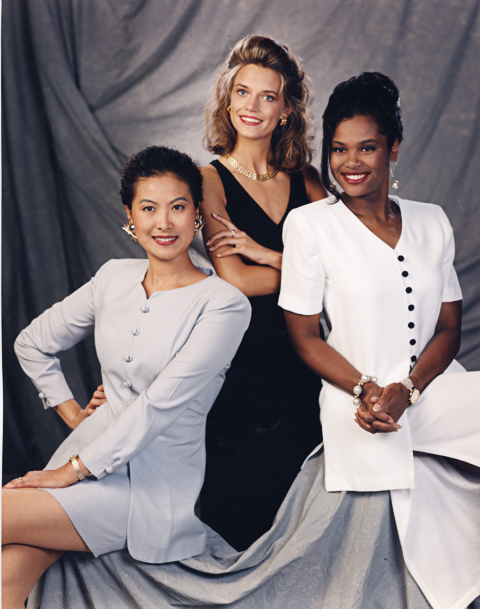
In the 1990s, after complaints from consumers and the interest in other markets, reference cards with different skin tones started to appear. Reproduced with permission of Eastman Kodak Company
As television content has become more racially integrated over the years, technical apparatus changes have also emerged to address the challenge of diversity. The most advanced thinking about color adjustments embedded within digital television cameras in the early 1990s came from the Philips Corporation in the Netherlands. Philips was a forward- thinking company and invested in a team that included Senior Video Designer Jan Van Rooy, Media consultant, Greg Pine, and a collaboration with Ikegami in Japan. Their mandate was to consider the problems that cameras would have to resolve in the future as they took on a more global marketing perspective. The experience of North American television problems apparently formed the basis of their concerns. They pointed out how Whoopi Goldberg, a very popular darkskinned American actress, had to be colour-calibrated with a completely different setting than that of Barbara Walters, well-known American interviewer with pale skin, if they were to be shot in the same frame. It was an impossible situation and for a while, each had to be shot and colour-balanced with a separate camera and electronically merged in the control room. To solve this technical problem, Rooy’s team came up with a prototype camera in which there were two separate computer chip memory settings and storage areas for skin-tone standards – one for the darker, the other for the lighter range.
The team also developed the added asset of digital cosmetics which can be set to modify age lines, wrinkles, and blemishes in a way comparable to how Photoshop works.
Intelligent design matters
One would assume that when digital cameras entered the marketplace, problems similar to those that had occurred in using Shirley as the “normal fleshtone” for various practices around skin colour calibrations would have been bypassed or surmounted. That was not always the case.
Take, for example, the Hewlett Packard webcam launched in 2009 and claimed to be able to detect and track faces. When it began to be tested by a diversity of consumers, it became apparent that it could only detect light skinned faces and did not trigger the tracking response at all for those with darker skins.
In 2010, Nikon’s Coolpix S630 also failed to recognize Asian consumers who had to respond to a pop-up message of “Did someone blink” every time they used its face-detection software. In 2015, Google embarrassingly apologized for its App autotags where it identified Dark skinned people as “gorillas.”
And there is currently a controversy about Instagram in which some argue that the platform has skewed its optional filters to accommodate the widespread perception that whiteness is still the dominant aesthetic norm of preference.
In all of these cases, the central problematic issue did not lie in a technological limitation so much as in a lack of imagination as to who the products’ potential users would be, along with a matched recognition of their skintone diversity embedded in the algorithms used to control their outcome. Furthermore, the choice of test populations obviously shows a deficit in the range of flesh colours selected. How these products could be launched without adequate testing of an ethnically-diverse global market shows the level of insight about race relations of their manufacturers. There is an embedded moral issue here as well as one of explicit cost and marketing strategy.
Clearly, technologies cannot in and of themselves be racist. They are created by people who have framed their infrastructure by economics and cultural design decisions. And the trajectory of skintone reproduction in digital media imagery is a continuation of that which began with analog Shirley cards.
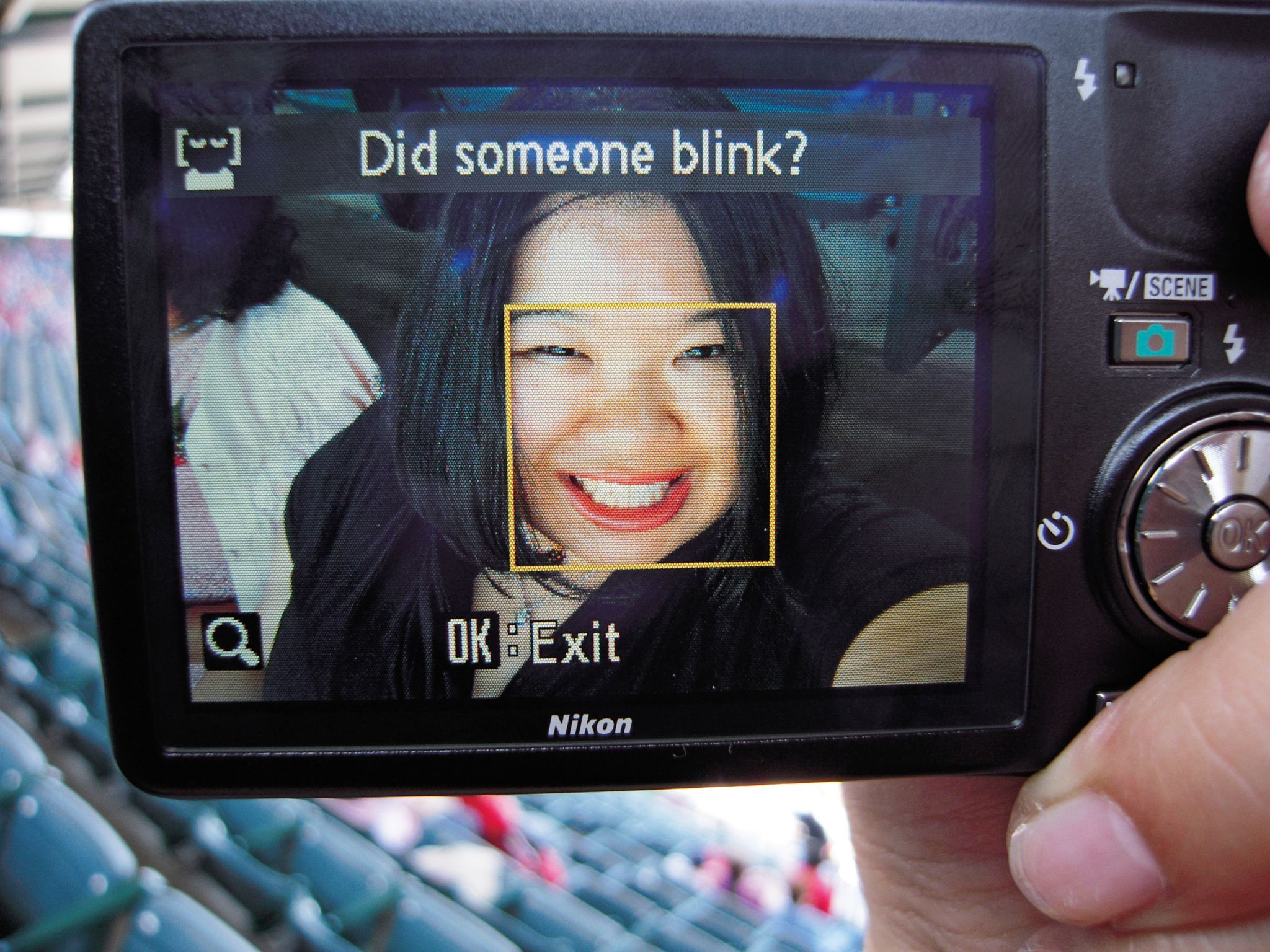
“Did someone blink?” The digital photography era continues to generate embarrassing situations, like the one caused in 2010 by this Nikon camera, which had dif - culty to distinguish facial features. JOZ WANG COLLECTION
Were these technical designers racist? Rather than be conspiratorial, I would suggest they had a low level of awareness around representations of race embedded in their practices. When these designers became more aware of the troubling implications of their decisions within the Afro-American community, colour-adjustment strategies were quickly developed to overcome the initial barriers.
In analog imagery, this was demanded by market concerns. Within the digital mediasphere, it happened more frequently when civil rights movement advocates became more powerful and vocal over time. The public outcry of potential consumers is now the most common driving force catalyzing advances in quality control over skintone rendition. In most cases, adjustments are not initiated by the manufacturers themselves.
How our everyday technologies and visual products function, and what they favour and ignore, has been coloured by the assumptions of the cultural and financial intermediaries involved in decisions about their design and marketing. Intermediaries populate backroom labs and board rooms of technical enterprises and it is they who channel patterns of embedded cultural norms through their products into the dominant cultural and visual regimes of representation.
These, in turn, act as implicit teaching tools for framing our visual world. Embedded in our worldviews, these templates can enable or constrain the development of an anti-racist common sense to guide our visual perceptions of what diversity means in a given society.
It is timely to argue for a new way of understanding the visual industries in relation to a form of racial and cultural equity that doesn’t revolve around statistics, legislation, and access to institutions. Rather, by directly inscribing an algorithmic vision of full-spectrum flesh-tone equity into the various technological apparatuses of visual media, an alternative set of embedded skin colour norms could trigger more equitable representations of success, beauty, and belonging – although there are never any guarantees of a positive outcome. Diversity, after all, does not equal power. ///

In 2015, Google publicly apologized after the new automated photos classi cation application identi ed two african-americans as gorillas.
Lorna Roth is professor and former Chair person of the Department of Communication Studies at the Concordia University, in Montreal. She is author of Something New in the Air: The Story of First Peoples Television Broadcasting in Canada (McGill-Queen’s University Press, 2005) and is currently working on a series of articles and her second book, entitled Colour-Balance: Race, Technologies, and “Intelligent Design”.
///
Get to know ZUM’s issues | See other highlights from ZUM #10 | Buy this issue
Tags: racismo



